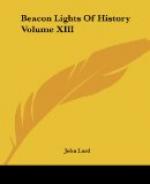his crowning and establishment on the throne; next
comes ‘Gareth and Lynette,’ a tale of love
and scorn, and of the conflict between a false pride
and a true ambition; to this is appended ‘The
Marriage of Geraint,’ of Arthur’s court,
and a member of the great order of the Round Table.
Next follows ’Geraint and Enid,’—Enid,
the gentle and timid, whom Geraint had married after
wooing the haughty Lynette,—a tale of pure
and loyal womanhood, darkened for awhile by the clouds
of jealousy and suspicion, yet closing happily long
after the “spiteful whispers” had died
down, and Geraint, assured of Enid’s fealty,
had ruled his kingdom well and gone forth to “crown
a happy life with a fair death” against the
heathen of the Northern Sea, “fighting for the
blameless King.” The next Idyll relates
how the venerable magician Merlin succumbs to the
thrall of the wily harlot Vivien, decked in her rare
robe of samite, and yields to her the charm which was
his secret. ‘Lancelot and Elaine’
follows with its conflict between the virgin innocence
of Elaine, the lily maid of Astolat, and the guilty
passion of the noble though erring Lancelot. To
this, in order, succeeds ‘The Holy Grail,’
telling of the vain quest of Arthur’s Knights
for the sacred relic. Despite its mystic character,
this is admittedly one of the finest of the series
of Idylls, and rich in its spiritual teaching,—that
the heavenly vision is to be seen only by the eyes
of purity and grace. ‘Pelleas and Ettarre’
is a tale of dole, showing the evil at work at the
court, and the wrecking effect of another woman’s
perfidy. ‘The Last Tournament’ has
for its hero the court fool, who, amid the treason
of Arthur’s knights, is firm in his loyal allegiance
to the King. In contrast to him is Sir Tristram,
who, despite his prowess, in jousts on the tilting-field,
is “one to whom faith is foolishness, and the
higher life an idle delusion.” The climax
is reached in ‘Guinevere,’ whom, in spite
of her faithlessness and guilty intrigue with Lancelot,
Arthur, with his great high soul, pityingly loves and
forgives. The end comes with the sad though shadowy
‘Passing of Arthur,’ the royal barge mysteriously
carrying him out into the beyond, whence issue sounds
of hail and greeting to the victor-hero
“——as
if some fair city were one voice
Around a king returning
from his wars.”
In 1864 Tennyson published “Enoch Arden,”
an idyll of the hearth, depicting a pathetic incident
in a seafarer’s career, of much simple idyllic
beauty. The poem has some fine descriptive passages,
and many examples of the poet’s rich word-painting
in treating of the splendid tropic scenery among which
the mariner is for the time cast. The volume
contained also some minor pieces, including the dialect
poem, ’The Northern Farmer,’ with its
humorous rendering of yokel speech. This was
followed (1875-84) by three dramas on English historical
themes, which, as the poet had not, as we have already
hinted, the gifts of a Shakespeare, were somewhat




